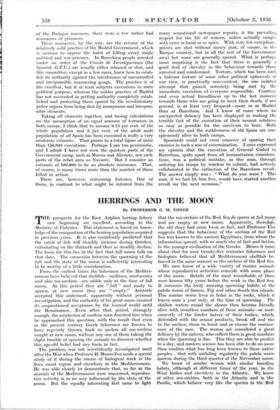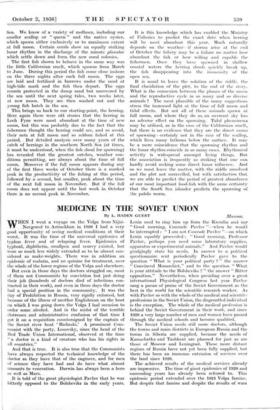HERRINGS AND THE MOON
By PROFESSOR C. M. YONGE
THE prospects for the East Anglian herring fishery now beginning are excellent, according to the Ministry of Fisheries. This statement is based on know- ledge of the composition of the herring population acquired in previous years. It is also confidently predicted that the catch of fish will steadily increase during October, culminating on the thirtieth and then as steadily decline. The basis for this lies in the fact that full moon falls on that date. - The connexion between the spawning of the fish and the state of the moon is sufficiently interesting to be worthy of a little consideration.
From the earliest times the fishermen of the Mediter- ranean have believed that shellfish—molluscs, crustaceans and also sea-urchins—are edible only at the time of full moon. At this period they are " full " and ready to spawn, at new moon they are " empty." Aristotle accepted this statement, apparently without personal investigation, and the authority of his great name ensured its unquestioned acceptance by the learned world until the Renaissance. Even after that period, strangely enough, the scepticism of modern man deserted him when he approached this question, with the result that even in the present century Greek fishermen are known to have regularly thrown back as useless all sea-urchins caught at new moon, without any one of them taking the slight trouble of opening the animals to discover whether this age-old belief had any basis in fact.
The problem was not scientifically investigated until after the'War when Professor H. Munro Fox made a special study of it during the course of biological work in the Suez canal region and elsewhere in the Mediterranean. He was able clearly to demonstrate that, so far as the animals of the Mediterranean were concerned, reproduc- tive activity is in no way influenced by the state of the moon. But the equally interesting fact came to light that the sea-urchins of the Red Sea do spawn at full moon and are empty at new moon. Apparently,- there the old story had some basis in fact, and Professor Fox suggests that the behaviour of the urchins of the Red Sea was known to the ancient Egyptians, from whom the information spread, with so much else of fact and fiction, to the younger civilisation of the Greeks. 'Hence it 'Caine about that for over twenty-five centuries fishermen and biologists believed that all Mediterranean shellfish -be- haved in the same manner as the urchins of the Red` Sea.
We now know of a wide variety of marine animals whose reproductive activities coincide with some phase of the moon. Details of the most remarkable of these were known fifty years before the work in the Red Sea. It concerns the truly amazing spawning habits of the palolo worm of Samoa, Fiji and other South Sea islands. This marine worm lives in holes in the rocks, which it leaves onee a year only, at the time of spawning. The shallow waters round the shores then become literally alive with countless numbers of these animals=-or more correctly of the hinder halves of their bodies, which, distended with the sexual products, break off and rise to the surface,'there to burst and so ensure the continu- ance of the race. The worms are considered a' great delicacy by the natives, who collect them in great numbers when the spawning is due. This they are able to predict to a day, and modem science has been able to do rio more than confirm what: has long, been known to these native peoples : that with' unfailing regularity the palolo worm spawns during the third quarter of the November moon.
We know of similar 'worms with similar breeding habits, although at different ' times of the year, in the West Indies and elsewhere in the Atlantic; We know of -other sea-urchins. both in the Atlantic and in 'the Pacific, whiclrbehave very like the 'species. in the-Red Sea. We know of a variety of molluscs, including our smaller scallop . or " queen " and the native oyster, which, spawn either exclusively or to maximum extent at full moon. Certain corals show an equally striking lunar rhythm in the discharge of the minute planulae which settle down and form the new coral colonies.
The first fish shown to behave in the same way was the little Californian smelt, which spawns from March to June. During this period the fish come close inshore on the three nights after each full moon. The eggs are laid and fertilised in burrows under the sand at high-tide mark and the fish then depart. The eggs remain protected in the damp sand but uncovered by the sea until the next spring tides, two weeks later, at new moon. They are then washed out and the young fish hatch in the sea.
This, brings us back to our starting-point, the herring. Here again there were old stories that the herring in Loch ,Fyne were most abundant at the time of new moon, but this was probably due to the fact that the fishermen thought the herring could see, and so avoid, their nets at full moon and so seldom fished at this period. , But detailed analysis over many years of the catch of herrings in the southern North Sea (at times, it must be understood, when the fish shoal for spawning) has . rev,ealed that the greatest catches, weather con- ditions permitting, are always about the time of full moon, Moreover if the full moon appears during any of the first three weeks of October there is a marked peak in the ,productivity of the fishing at this period, followed by a second, but smaller, peak about the time of the next full moon in November. But if the full moon does not appear until the last week in October there is no second peak in November. It is this knowledge .which has enabled the Ministry of Fisheries to predict the exact date when herring will be most abundant this year. Much naturally depends on the weather—if storms arise at the end of October the fishery may be a failure no matter how abundant the fish or how willing and capable the fishermen. Once they have spawned in shallow coastal waters the herring shoals quickly break up, the fish disappearing into the immensity of the open sea.
It is usual to leave the solution of the riddle, the final elucidation of the plot, to the end of the story. What is the connexion between the phases of the moon and the reproductive cycle in so many and so diverse animals ? The most plausible of the many suggestions stress the increased light at the time of full moon and tidal effects. But not all of these animals spawn at full moon, and where they do so, an overcast sky has no adverse effect on the spawning. Tidal phenomena may be utilised, as in the case of the Californian smelt, but there is no evidence that they are the direct cause of spawning—certainly not in the case of the scallop, which lives many fathoms below the surface. It may be a mere coincidence that the spawning rhythm and the lunar rhythm coincide in so many cases. Rhythmical activity is widespread amongst living things. But the association is frequently so striking that one can hardly avoid seeking some direct lunar influence. And so we must leave the matter, with the riddle unsolved and the plot not unravelled, but with satisfaction that, we are able to predict the period of greatest abundance of our most important food-fish with the same certainty that the South Sea islander predicts the spawning of the palolo worm.











































 Previous page
Previous page